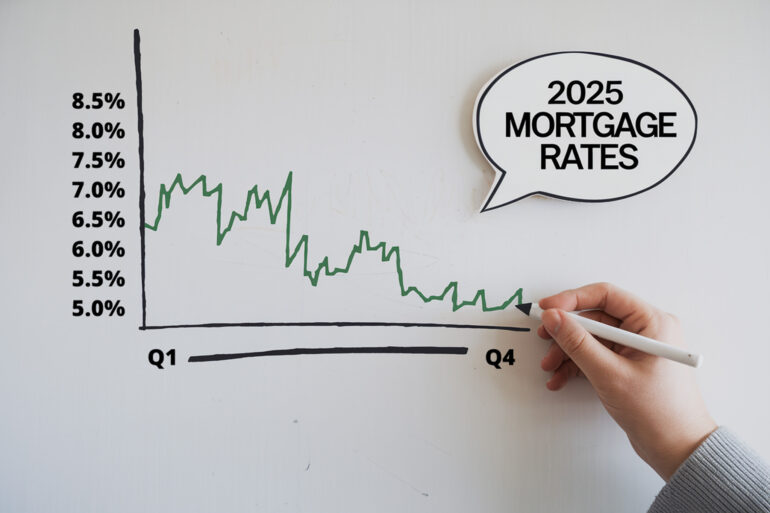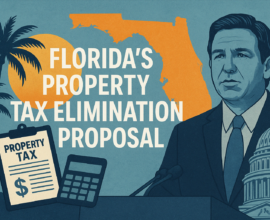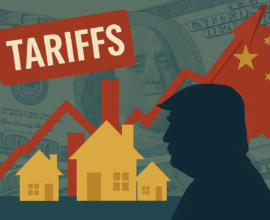2025 Mortgage Rate Forecast: What to Expect in the Year Ahead
As we move into 2025, many homeowners, buyers, and investors are closely monitoring mortgage rates, pivotal in shaping housing affordability and investment decisions. After a turbulent few years, mortgage rates have shown signs of stabilization in late 2024. However, questions remain about their trajectory in the coming year. This article delves into the major factors shaping mortgage rates, the outlook for 2025, and their implications for the housing market.
The Role of Federal Reserve Policy
The Federal Reserve’s actions are central to understanding mortgage rate trends. Over the past two years, the Fed aggressively raised interest rates to combat inflation. As inflation has started to cool, the Fed has shifted gears, implementing two rate cuts in late 2024 and signaling a potential third reduction in early 2025. These policy changes aim to stimulate economic activity by reducing borrowing costs, including mortgages. According to Federal Reserve updates, this trend may continue if inflation remains controlled.
It’s worth noting that while the Fed doesn’t set mortgage rates directly, its actions influence broader financial markets, including the yields on Treasury bonds. Mortgage rates often follow the trajectory of the 10-year Treasury yield, making Federal Reserve decisions a critical indicator for future rate movements. Staying attuned to these changes can provide valuable insights into market timing for prospective borrowers.
A drop in rates below 6% for current homeowners could unlock new refinancing opportunities.
Inflation and Economic Resilience
Inflation continues to influence mortgage rates, albeit less significantly than in previous years. While still slightly above the Federal Reserve’s target of 2%, the latest data from the Consumer Price Index (CPI) shows a steady decline. This cooling inflationary pressure has created a more favorable environment for rate stability. Coupled with a resilient labor market — characterized by steady job growth and low unemployment — the U.S. economy provides a stable backdrop for the housing market. Employment trends highlight strong consumer confidence, which often supports housing demand.
Inflation impacts not just mortgage rates but also broader housing affordability. As inflation declines, it could ease the cost of building materials, labor, and other inputs that affect home prices. This combination of lower inflation and potentially stabilizing home prices could create an opportune environment for buyers in 2025.
Predictions for 2025 Mortgage Rates
Expert forecasts for 2025 present a cautiously optimistic picture. The National Association of Realtors (NAR)anticipates an average 30-year fixed mortgage rate of around 6%, a slight decrease from late 2024 levels. This reduction will improve affordability and stimulate new construction and demand for existing homes.
Similarly, the Mortgage Bankers Association (MBA) projects rates starting at 6.6% in early 2025 and gradually decreasing to 6.3% by year’s end. These predictions align with expectations of a more balanced economy and subdued inflation.
However, some forecasts remain cautious. Realtor.com predicts a 6.3% average for the year, emphasizing that rates will likely stay elevated compared to pre-pandemic levels.
While these predictions suggest modest relief for borrowers, it’s important to remember that mortgage rates are influenced by a complex interplay of factors, including global economic trends, geopolitical stability, and domestic fiscal policies. Borrowers should monitor these variables to understand potential rate shifts better.
For investors, 2025 presents an opportunity to reassess portfolios and align strategies with evolving market conditions.
Implications for Borrowers
Mortgage rate movements in 2025 will have varying effects on different groups of borrowers.
For first-time homebuyers, even a modest decline in rates could enhance affordability. However, many regions’ limited inventory and high prices may still create challenges. Prospective buyers must prepare for competitive markets, especially in high-demand areas. Building a strong credit profile and securing pre-approval can help buyers stand out in such markets.
A drop in rates below 6% for current homeowners could unlock new refinancing opportunities. Depending on associated costs, many homeowners with mortgages locked in at higher rates may consider refinancing to reduce monthly payments. Refinancing provides an opportunity to consolidate debt or fund home improvements, offering additional financial flexibility.
Real estate investors, too, stand to benefit from lower rates. Reduced borrowing costs can improve cash flow on rental properties and make long-term investments more attractive. Nonetheless, investors should remain vigilant about local market conditions and fluctuations in rental demand. In regions where rent growth has slowed, it may take longer to recoup investments.
Regional Market Dynamics
The impact of mortgage rates in 2025 will vary significantly across regions. For instance, Florida’s housing market remains one of the most robust, driven by high Miami and Palm Beach demand. Even with slightly lower rates, affordability challenges may persist due to continued price growth. Florida’s appeal to remote workers and retirees ensures ongoing demand, but buyers should expect stiff competition.
In California, where home prices are among the highest in the nation, even minor rate changes can dramatically affect affordability. Adjustable-rate mortgages (ARMs) might increase popularity among buyers seeking lower initial payments. California’s diverse economy and limited housing supply create unique pressures, making rate-sensitive strategies essential for prospective buyers.
Meanwhile, the Midwest, known for its comparatively affordable housing, could experience increased buyer activity if rates decline. This region’s lower price points make it less sensitive to changes in borrowing costs, offering opportunities for buyers looking for value without excessive competition.
Whether planning to buy, sell, or refinance, 2025 offers opportunities for those who stay prepared and proactive.
2025 Is A Transitional Year for Mortgage Rates
As Lawrence Yun, Chief Economist at NAR, notes, “We expect rates to trend downward but remain elevated compared to pre-pandemic levels. Buyers and sellers will need to adjust their strategies accordingly.”
Mortgage brokers echo this sentiment. They stress the importance of timing and preparation when securing a mortgage. “If you’re planning to buy or refinance, work closely with your lender to lock in favorable terms,” advises a spokesperson for Rocket Mortgage.
Borrowers should also consider the long-term implications of their mortgage choices. Fixed-rate loans offer stability in uncertain markets, while ARMs may provide short-term savings but come with risks if rates rise unexpectedly. For investors, 2025 presents an opportunity to reassess portfolios and align strategies with evolving market conditions.
Looking Ahead: Opportunities and Challenges in 2025
The 2025 mortgage rate outlook suggests a year of gradual improvement. While rates are expected to decline modestly, they will likely remain above historical averages. For prospective buyers, current homeowners, and investors, staying informed about economic conditions and regional market dynamics will be key.
Understanding the broader economic landscape — including Federal Reserve policies, inflation data, and housing supply trends — will help borrowers and investors make strategic decisions. Whether planning to buy, sell, or refinance, 2025 offers opportunities for those who stay prepared and proactive.
By anticipating market changes and seeking professional guidance, borrowers can make informed decisions that align with their financial goals. With careful planning, 2025 could be a pivotal year for achieving long-term success in real estate.








